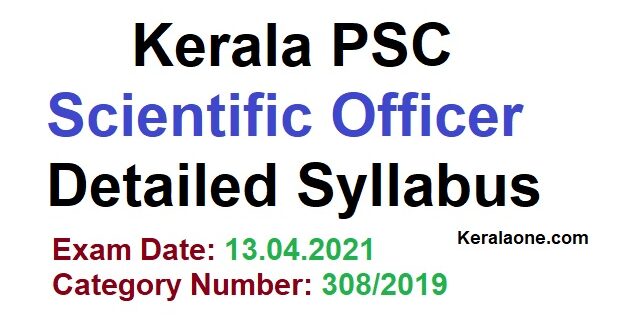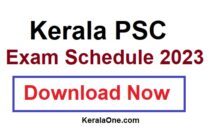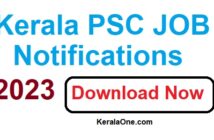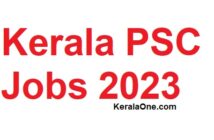Deprecated: Creation of dynamic property InsertPostAds::$settings is deprecated in /home4/keralaon/public_html/wp-content/plugins/insert-post-ads/insert-post-ads.php on line 427
KPSC Scientific Officer Syllabus April 2021| Category Number 308/2019
Kerala PSC Scientific Officer Syllabus:- Kerala Public Service Commission (KPSC) has issued detailed syllabus for the Scientific Officier vacancies in Chemical Examiners Laboratory Department. Candidates who applied for the vacancies can find the Scientific Officer Detailed syllabus here.
Scientific Officer Exam Details
| Name of the Post | Scientific Officer |
| Department | Chemical Examiners Laboratory |
| Organisation | Kerala Public Service Commission |
| Category Number | 308/2019 |
| Exam Date | 13.04.2021 Tuesday |
| Hall Ticket Available From | 09.02.2021 to 29.03.2021 |
Kerala PSC Scientific Officer Detailed Syllabus
BIOCHEMISTRY
MODULE – I: Biomolecules and Biochemical techniques
Overview of physical aspects in Biochemistry, Classification, Structure and functions of
carbohydrates, Lipids, Proteins and nucleic acids. Methods for the isolation, purification and
characterization of protein, denaturation of proteins and nucleic acid. Nucleic acid sequencing,
proteome analysis.
Microscopy:- Basic principles, instrumentation and applications of microscopy. Bright field,
phase-contrast, fluorescence and confocal microscopy. Electron microscope – scanning and
transmission electron microscopy. Principle methodology and applications of different types of
electrophoresis, blotting and PCR techniques.
MODULE – II: Nutrition and Biochemical basis of diseases.
Nutritional aspects of Carbohydrates, lipids, proteins and fibre Nutritional Value of
vitamins, minerals – Physiological and Biochemical functions, Daily requirement, Protein-energy
malnutrition – Kwashiorkor, Marasmus- aetiology, metabolic disorders and management. Diseases
related to digestion and absorption of food.
Composition of the blood, Plasma Proteins, Formed elements – overview, Coagulation,
Haemoglobin metabolism and Chemistry of Respiration, Abnormal Hemoglobin and their
deficiencies, Renal Function, Liver and detoxification, Liver diseases, Renal function test, liver
function test. Inborn errors of metabolism, Antibiotics – the action of Penicillin, Streptomycin,
Tetracyclin, Chlorophenicol, Rifampicin.
MODULE -III: Metabolism and Enzymology
Metabolism of carbohydrates -glycolysis, glycogen metabolism, citric acid cycle, Pentose
Phosphate pathway, Gluconeogenesis, Bioenergetics – Ultrastructure of Mitochondria, electron
transport chain, oxidative Phosphorylation, Metabolism of lipids – Fatty acid synthesis and
degradation, Ketone, bodies, Cholesterol metabolism – Eicosanoids, phospholipid metabolism,
Metabolism of lipoproteins, Metabolism of amino acids and nucleic acids. Regulation of
metabolic pathways. Associated metabolic disorders.
Nomenclature and classification of enzymes, isolation and purification of enzymes,
Enzyme Kinetics, Enzyme inhibition, vitamins as coenzymes, Active site, Mechanism of
Enzyme action, Regulation of enzyme activity, Allosteric enzymes, Isoenzymes, Industrial and
clinical applications of enzymes.
MODULE-IV: Molecular biology and immunology
Genetic information carriers-DNA replication(prokaryotes and eukaryotes) and Repair,
Transcription and translation(prokaryotes and eukaryotes), post-transcriptional processing, post
translational modifications, types of RNA, genetic code, regulation of transcription and
Translation, operons, gene silencing, micro RNA, epigenetics.
Overview of the Immune system, Cellular components of the immune system, Nature of
Antigen and Antibody, Innate immunity, Soluble factors, Inflammation, Phagocytosis. Adaptive
Immunity, Lymphocyte, T and B cell maturation, Clinical Immunology, Antigen-antibody
interactions, Diagnostic Techniques, Applications, Immunodeficiencies, Immuno therapy.
CHEMISTRY
Unit I – Structural and Solid-state Chemistry
Theories of Metal Complexes – LFT CFT, Spectral and Magnetic properties of transition
metal complexes, Term symbols, Selection rules for electronic transition, Spin-orbit
coupling. Organometallic compounds- Isolobal analogy. Metal carbonyls, Complexes with
linear π donor ligands, Olefins, acetylenes, dienes and allyl complexes. Complexes with
cyclic π donors, Fluxionality. Interhalogens, Sulphur-Nitrogen compounds, Phosphazines
and Boron compounds, Wade’s Rule. Metallaboranes and metallacarboranes. Spectral and
Magnetic properties of Lanthanides and Actinides, Shift Reagents.
Crystalline state – Crystal systems and lattice types, Bravais lattices. Crystal symmetry,
Point groups and space groups. Miller indices, Reciprocal lattice concept, X-Ray
diffraction by crystals, Structure factor, Fourier synthesis. Perovskite, Spinels, Inverse
spinel structures.
Solid-state Chemistry- Superconductivity, Photoconductivity, Photovoltaic effect. Colour
in inorganic solids. Dielectric properties- Ferroelectricity, pyroelectricity, piezoelectricity.
Unit II- Stereochemistry and Spectroscopy in Organic Compounds
Structure and Stereochemistry, Correlation of structure and reactivity, Aromaticity of
annulenes, Non-benzenoid aromatics, Molecular chirality, Stereochemical nomenclature
of compounds with chiral centres, axis and planes, Prostereoisomerism, Non-carbon chiral
centres, Atropisomerism. Reactions of sp3, sp2 Carbon and aromatic systems, Cram’s rule.
Felkin-Anh Model. Reactive Intermediates and Rearrangement Reactions.
Pericyclic Reactions, electrocyclic, cycloaddition and sigmatropic reactions, 1,3-dipolar
cycloadditions, ene reactions, cheletropic reactions, Woodward-Hoffmann selection rules.
Organic Photochemistry, Primary photo processes aromatic photo rearrangements. Chemi
and bioluminescent reactions. Organic structure elucidation by spectroscopy- 1H and 13C
NMR chemical shifts and coupling constants of organic compounds. UV-VIS spectra of
enes, eneones, arenes and conjugated systems. Woodward-Fieser rules, Structural features
by IR. Mass Spectroscopy in organic structure analysis
Unit II- Theoretical Chemistry and Kinetics
Quantum Mechanics- Wave functions, Concept of Commutators. Eigenfunction and eigenvalues, Tunnelling. Zero-point energy and significance, Radial probability distribution
function and graphs. Maxwell-Boltzman, Bose-Einstein and Fermi-Dirac statistics.
Symmetry elements and symmetry operations- Point groups, Applications of character
tables to spectroscopy.
Molecular Spectroscopy- Theory of Microwave spectroscopy, Infrared spectroscopy,
Raman spectroscopy, Electronic spectroscopy, Resonance spectroscopy-NMR, ESR &
Mossbauer.
Influence of temperature and pressure on transport properties, Mean free path, Collision
diameter, Collision Theory. Activated complex theory. Order and molecularity of
reactions. Steady-state approximation. Kinetics of fast reactions, Relaxation spectrometry,
Flash photolysis. Factors influencing reaction rates in solution. Catalysis-Mechanism and
theories of homogeneous and heterogeneous catalysis.
Unit IV- Instrumentation methods in Chemical Analysis
Instrumentation and application of Radiation Analysis Methods- Detection counters.
Geiger counter, scintillation counters, Neutron activation analysis. Isotope dilution
methods. radioactive tracer techniques and its applications. Electroanalytical MethodsPrinciples, Instrumentation and applications of Electrogravimetry, Coulometry,
Polarography, Amperometry, Cyclic voltammetry, Potentiometry and Conductometry.
Thermal and Surface Analysis Methods- Principles, instrumentation and applications of
TG, DTG, DTA, DSC. Introduction to, SEM, TEM, AFM STM, and other surface
characterization techniques.
Chromatographic Methods- Principles, instrumentation and applications of column
chromatography, paper chromatography, thin layer chromatography, ion-exchange
chromatography, gas chromatography and liquid chromatography. Hyphenated techniques,
Instrumentation of of UV-Visible Spectrometer, IR and Spectroflurometer, AAS, AES, ,
ICP AES, XPS Radiation Sources for UV Visible and Infrared Monochromators.
Detectors-CCD, Photomultiplier Tube, Michelson Interferometer.
FORENSIC SCIENCE
Unit I
Forensic science: definition, history and development, ethics in forensic science.
Courts : types, powers and jurisdiction.
Forensic jurisprudence.
Organisation of forensic science laboratories of centre and state, NCRB and NICFS.
Crime scene: Nature, types, preservation of scene of crime, collection and preservation of
evidence.
Unit II
Physical evidences: Nature, types, search methods, collection and preservation.
Hair and fibres- types, structure, examination with different instruments.
Soil- nature, types, examination, forensic importance.
Paints, lacquers, varnishes- nature, composition and forensic examination.
Examination and analysis of cement, mortar and concrete.
Unit III
Forensic medicine
Modes and manners of death, sexual offences-Medico-legal importance, Amendments in laws
related to sexual offences.
Post-mortem changes and estimation of time since death,
Individual identification from skeletal remains, determination of species of origin, sex, age,
stature.
Skull superimposition and recent advancements in facial reconstruction.
Human dentition, type of teeth, bite marks, estimation of age from teeth.
Cheiloscopy.
Asphyxia: classification and signs.
Injuries & Wounds: types, classification and medico-legal importance.
Unit IV
Toxicology
Analysis of Illicit liquors.
Analysis of ethyl alcohol in biological fluids and breath.
Plant poisons- active principles and mode of action.
Metabolism and chemical examination of drugs of abuse, narcotics, sedatives, hypnotics.
Toxicity and analysis of insecticides and pesticides.
Identification and extraction of common poisons from viscera, tissues and body fluids
including clean-up procedures.
Unit V
Ballistics
Classification and examination of firearms and projectiles.
Ammunition- composition and examination.
Basics of Internal, external and terminal ballistics.
Analysis of gunshot residues.
Phenomena associated with projectile- Yaw, Richocet, Accidental discharge.
Determination of range and velocity in firearms.
Fire and Arson
Analysis of incendiary materials and petroleum products.
Explosives: definition, types and analyses.
Bombs and IEDs and their examination.
Investigation in explosion and arson related cases.
Unit VI
Instrumentation
Microscopy- Comparison, Stereoscopic, Polarising, Stereoscopic, Fluorescent and Electron
microscope
X-Rays and x-ray based techniques- fluorescence and diffraction.
Neutron Activation Analysis
Mass spectroscopy.
Spectrometry- UV, Visible, IR, Raman, Atomic Absorption, Emission.
Chromatography- TLC, GC, HPLC, HPTLC, and associated hyphenated techniques.
Electrophoresis, immunoassays.
Photography- types and application.
Unit VII
Computer forensics- types of digital evidences, seizure and examination.
Mobile phone forensics- tools and analysis.
Biometric systems of identification-relevance and application.
Voice analysis- introduction, significance, voice spectrography and analysis
Structure of human voice apparatus.
Criminal profiling: Polygraph –principles, PDD, Narco-analysis, Brain mapping.
Unit VIII
Biology and Serology
Bloodstains- identification and detection, blood group systems.
Determination of blood groups of stains and species of origin.
Detection of seminal and other fluids and their blood groupings.
Red cell enzymes, serum proteins and significance.
DNA structure, profiling, extraction and application.
RNA profiling and application.
Disputed paternity and maternity.
Unit IX
Tool marks: Types and examination, Restoration of erased markings.
Track marks: examination of foot prints, shoe prints, tire marks preservation and casting.
Wild life forensics: Wild life (Protection) Act 1972, scope, evidences and identification.
Forensic entomology, insects of forensic importance and application.
Forensic psychology: delusion-types, difference between psychosis and neurosis, lucid interval,
sections related with criminal responsibility of insane, rules related with criminal responsibility
of insane persons(McNaughten’s rule, Curren’s rule, Durrham’s rule), irrestible impulse test –
New Hampshire doctrine.
Unit X
Documents: types and forensic examination.
Age of documents, Inks, papers and their scientific examination.
Examination of alterations, obliterations and additions.
Hand writings: class and individual characteristics, factors affecting handwriting, indentations,
secret writings and writings on charred documents, anonymous and disguised writings.
Examination of typescripts and printed matters.
Examination of credit cards and similar materials.
Download KPSC Scientific Officer Notification 2020




